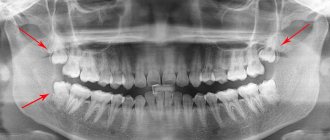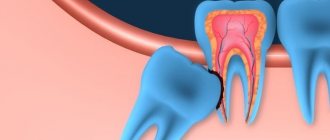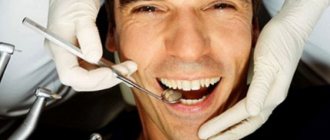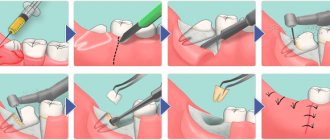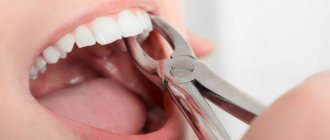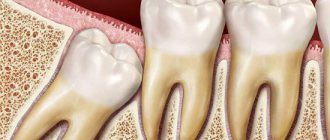Removal of wisdom teeth due to caries
Why are wisdom teeth most often affected by caries?
Most often, caries of wisdom teeth develops due to the fact that they are located far enough away and do not participate in the act of chewing.
And if the teeth are not involved in the act of chewing, then it is extremely difficult to clean them due to the fact that the teeth are cleaned not only during hygiene, but also during each meal - on their own. On the picture
– what caries looks like on the bottom eight.
You can see how the lower wisdom tooth is removed due to caries HERE. By the way, there, in clinical cases, you can see how the removal of an upper wisdom tooth occurs.
Often the patients themselves neglect these teeth, brush the eights less carefully and caries develops quite quickly, the wisdom tooth begins to hurt, so it will be easier to remove such a tooth than to treat it.
Can caries cause wisdom tooth removal?
Should wisdom teeth with caries be removed? Yes. Removal of the figure eight, if there is caries, is carried out due to the inappropriateness of its treatment.
In most cases, we do not chew with these teeth, and treating wisdom teeth is quite difficult and problematic. And most importantly, this makes absolutely no sense.
Removing the bottom eight can be seen HERE
There is also a situation when the wisdom tooth is strongly inclined, “lying” and covered with caries. In this case, there is also absolutely no point in treating wisdom teeth.
.
If your wisdom tooth gets injured: chipped or cracked?
Should it be removed? A chip, crack, or injury to a wisdom tooth is a 100% indication for removal
wisdom tooth There is absolutely no reason to fight to save him.
What problems may arise
- almost 80% of cases
, the eruption of third molars is accompanied by various purulent-inflammatory processes.
A mucous hood
is formed over the erupting unit , a pocket is created around it, where bacterial plaque and food debris accumulate, which leads to purulent inflammation -
pericoronitis
. - Often, figure eights grow towards the tongue, cheek, palate, constantly injuring the mucous membrane, causing a lot of painful and uncomfortable sensations. Chronic injury to soft tissues
can lead to the formation of ulcers, erosions, and the development of leukoplakia (hyperkeratosis) - the mucous membrane in the injured area becomes denser. If the cause (traumatic tooth) is not eliminated, there is a risk of neoplasm (including malignant). - Between 8 and 7 (on contact surfaces) a carious cavity is formed
where food is constantly clogged, contributing to the rapid development of caries. The carious process affects not only the number eight, but also the 7th molar, which is important for the dental apparatus. In case of interdental caries, it is necessary to remove the wisdom tooth and properly treat the seventh molar. - Sometimes the figure eight, positioned horizontally in the gum, rests on the root of a neighboring tooth, injuring it, causing the formation of a cyst
. In the worst case scenario, such a pathology can even lead to resection of the jaw bone. As a result of a long asymptomatic period, cysts can acquire significant sizes and damage the surrounding bone tissue and neighboring units. - Wisdom teeth can put serious pressure on adjacent units, moving them out of place. This pressure is transmitted to all teeth, causing row deformations
, malocclusion, and periodontal disease.
Wisdom teeth during orthodontic treatment
Removal of wisdom teeth before orthodontic treatment
During the period of orthodontic treatment, when the bite is being corrected, the figure eights are also most often removed. Why?
Before orthodontic treatment, we need to remove teeth that are preventing all the remaining teeth - 28 teeth - from moving into place. As a rule, wisdom teeth do not provide freedom for such activities. We remove them and then perform orthodontic treatment.
In what cases are wisdom teeth not removed during orthodontic treatment?
In the case of large jaws, when the wisdom teeth are in an absolute row and they close correctly, in the correct occlusion, we do not need to remove them. We can leave them, we can also treat them, take care of them, like other teeth.
What is a wisdom tooth and where is it located?
The name “wisdom tooth” is assigned to the third molar, the so-called figure eight, the eighth tooth in a row. The period of wisdom teeth eruption is approximately from 20 to 27 years. In rare cases, they appear after 40 years. It is precisely with the age of eruption that the name of eights—“wisdom teeth”—is associated, because in fact they appear in a person during the period of maximum maturity of the body.
It is interesting that in some people, despite the presence of the rudiments of teeth, they may not erupt throughout their lives. Scientists explain this fact by the fact that in the process of evolution, modern people's jaw has become shorter by about 12 mm compared to their ancestors, which is due to softer food, when chewing which there is no heavy load on the jaw.
If figure eights do erupt, they often cause pain and discomfort to the person. If the jaw is small, then in the process of growth the eights can shift the dentition, which leads to the curvature of other teeth. Therefore, many people try to remove them whenever possible. But the very fact of having a “wise” tooth is not always a reason for its removal.
Impacted and dystopic wisdom teeth
Impacted wisdom tooth
- this is a tooth that has not erupted; it is located in the bone tissue, in the gum. The general practice is that few dentists decide to remove an impacted figure eight, since it is a complex procedure.
In the clinics of the German Implantology Center, removal of impacted wisdom teeth is carried out as planned; our experience allows us to perform surgery of this level.
Why don't wisdom teeth erupt?
The wisdom tooth does not erupt due to the fact that it is dystopic: there is a neighboring tooth in front of it, which is in the way.
This wisdom tooth is usually tilted. Or there is absolutely no room in the jaw, it is located at the corner of the jaw: there is no place for it to cut through, there is no way.
Dystopic tooth
A wisdom tooth is a tooth that is erupting or has erupted incorrectly. Or it cannot erupt and occupies the wrong position in the jaw.
Typically, such teeth displace other teeth, deforming the jaw. It is impossible to treat them, and straightening them is also extremely difficult. In these cases, we remove the dystopic wisdom tooth. As a result of dystopia, cheek injuries may also occur due to chronic biting. Therefore, it is better not to postpone the removal of the dystopic eight “for later”.
Removal of wisdom teeth in pregnant and lactating women
Removal of wisdom teeth in pregnant and nursing mothers
Is it possible to remove wisdom teeth during pregnancy? Pregnant and lactating women can have their wisdom teeth removed only in case of exacerbation of one of them or necessity, when it is impossible to solve this problem conservatively. In a planned manner, it is better to remove wisdom teeth after the end of the feeding period.
Are there any special features of removing wisdom teeth during pregnancy?
We try to perform tooth extraction on all our patients as carefully, comfortably, and carefully as possible. Therefore, as a rule, there are no technical features. But if any intervention in the form of wisdom tooth removal is urgently required (because there is no other alternative), we must consult with the attending physician - a gynecologist and, accordingly, coordinate all our actions.
What anesthesia is used when removing wisdom teeth in pregnant and lactating women?
In pregnant and lactating women, after consultation with a gynecologist, we, as a rule, perform anesthesia with a reduced level of adrenaline, so as not to provoke the onset of labor in the later stages, and not to provoke a miscarriage in the early stages.
Removal of a wisdom tooth near the maxillary sinus
If the wisdom tooth is located near the maxillary sinuses, there is a certain difficulty in such removal. Why?
If a wisdom tooth is located close to the maxillary sinus, there is a risk that during removal the tooth can be pushed into the maxillary sinus. If you make incorrect technical movements when removing a tooth, or work roughly in some way, you can harm the person and, accordingly, you will then need expensive long-term treatment to remove this tooth.
Are there any specifics to removing wisdom teeth?
Of course, there are some peculiarities when removing wisdom teeth. The doctor’s task is to make the removal process as accurate as possible, as atraumatic as possible - in principle, like the rest of the teeth. But in the case of a wisdom tooth, there are some peculiarities of anatomy.
The peculiarities are that the figure-eight tooth is located quite far away and quite well hidden. But at the same time, using modern equipment, modern materials and having experience, you can remove wisdom teeth quickly and accurately enough without consequences or injuries.
Competent removal of wisdom teeth
How to remove a wisdom tooth in the least traumatic way?
The wisdom tooth is removed atraumatically after carefully evaluating the computed tomography scan, talking with the patient, and assessing his clinical case. The tooth is separated - divided into parts if it has any bends, slopes, or several roots. And, accordingly, with the help of elevators, luxators - special dental instruments, it is carefully and carefully dislocated.
There is no need to worry about the appearance of some blood after wisdom tooth removal. The removal is carried out under the full supervision of a doctor; the wound after tooth extraction is sutured and sutures are applied. What follows is a standard rehabilitation protocol without any surprises for the patient. The only thing is that after the removal of a wisdom tooth (wisdom teeth), swelling of the mucous membrane is possible.
Why is atraumatic tooth extraction more preferable?
With this removal, the doctor takes care of the health of the patients. So that the healing takes place as comfortably as possible, so that there are no consequences after this, so that the patient in the near future, after 7-10 days, forgets that he had his wisdom tooth removed. It is after this time that possible swelling and pain after removal are completely removed.
Features of treatment
If the third molars are correctly positioned and the patient visits the clinic in a timely manner, wisdom teeth can be treated – therapeutically or medicinally.
If the doctor decides to remove the nerve, he may prescribe antibiotic treatment to stop the development of the inflammatory process. In case of painful sensations, analgesics will not help to cope with the cause of the disease; they are used only to wait for an appointment with the dentist without pain or to eliminate it after filling the canals. The main thing is not to put off visiting the clinic.
Pain after wisdom teeth removal
How long does pain last after wisdom tooth removal?
Pain after the removal of wisdom teeth lasts differently, depending on the sensitivity of the person and how the healing proceeds in general. It hurts after removing the figure eight from several days to, maximum, 7-10 days. Naturally, all pain, all painful symptoms from wisdom tooth removal subside over time.
What should you do if the wound hurts for a long time after wisdom tooth removal?
If you experience prolonged pain after wisdom tooth removal, you should contact your doctor as soon as possible, and he will adjust his prescriptions. If any problems arise, he will solve them.
Pros and cons of removal tactics for caries of the lower or upper eights
Advantages of the extraction (removal) method:
- it is possible to completely eliminate the infectious focus, prevent the spread of the inflammatory process to adjacent teeth and nearby tissues;
- eliminates the risk of crowded teeth and the need for orthodontic correction;
- the risk of recurrent caries is eliminated;
- removal of the third molar allows you to radically solve the issue of pain in the area of this tooth.
The negative aspects of removing wisdom teeth include the risk of postoperative complications, as well as the inability to install a support for bridges or crowns on the figure eights, if necessary.
When should wisdom teeth not be removed?
What can serve as a contraindication to wisdom tooth removal? A contraindication to wisdom tooth removal may be a person’s health condition, as a result of which we cannot subject him to such a surgical intervention.
For example, if the patient suffers a heart attack in the near future, within six months. Or he has some kind of uncompensated disease. In these cases, we first prepare the patient, consult with related specialists, and after that, as planned, we carry out removal procedures.
When is the best time to treat a tooth?
The moment of eruption of the third molar and its further condition is difficult to predict. Often this process is accompanied by pain in the tooth or jaw area, fever, increased salivation, swelling and redness of the gums, the formation of a hole in the tooth and other unpleasant sensations. This can happen at night, when an urgent visit to the dentist is not possible, or during the day, when the patient is busy with urgent matters. In both cases, it is necessary to quickly respond to painful symptoms - take medication.
To eliminate toothache and localize the inflammatory process, you can use the following remedies.
- Ibuprofen or Nimesil are drugs that will reduce the temperature.
- Metrogil-Denta or Cholisal will eliminate pain and swelling.
- Maraslavin, Mirastin or Eludril - solutions for mouth rinsing and compresses.
You can also use folk remedies that have proven themselves as adjuvant therapy in the treatment of dental diseases. To do this, it is recommended to rinse the mouth with a decoction of sage, infusions of oak bark or propolis. You can also prepare a mixture of salt and soda, which are dissolved in a 1:1 ratio in a glass of water at room temperature. You should rinse your mouth with a herbal solution every 2 hours, and with salt and soda – no more than 3 times a day.
After providing first aid at home, you should go to the dentist as soon as possible. To do this, you need to make an appointment with a dentist. An experienced specialist will quickly determine the cause of the patient’s suffering and prescribe adequate treatment or removal of the wisdom tooth.
Complications after wisdom tooth removal
What may be the cause of complications after removal of figure eights?
Complications after removing the figure eight - yes, they exist. Complications are different: they occur directly during the removal procedure, there are delayed ones, blood vessels may be damaged, and bleeding may occur. There may be a fracture of the jaw, a breakage of a section of bone tissue that is located in close proximity to the wisdom tooth.
Long-term complications – for example, wound infection in the case of unsterile instruments. If the doctor did not warn the patient that he needs to take antibiotics prophylactically for an impacted wisdom tooth.
What are the complications after wisdom tooth removal?
After the removal of a wisdom tooth, there are complications of different etiologies: they can either arise immediately or be delayed. Bleeding may immediately occur, your jaw may break, a piece of bone may break off (both small and large) - then your jaw will begin to hurt. You can tear the mucous membrane, injure a neighboring tooth, break a neighboring tooth, etc. Your gums or throat may begin to hurt.
Delayed complications are oral infection, periostitis, alveolitis, inflammation of bone tissue.
Can the temperature rise after wisdom tooth removal?
After the removal of a wisdom tooth, the temperature may rise in people who are very nervous or have suffered a lot of stress. This will be a vegetative-vascular reaction, and once the temperature can rise to 38.5-39 degrees. Once. It can be brought down by the use of antipyretic drugs and, accordingly, it should no longer be present. There may be a low-grade fever of 37 degrees, 37.1-37.2, for several days after removal. This does not have any consequences, this is normal, but you should, of course, inform the doctor about this so that he takes this fact into account and adjusts his prescriptions.
Can gumboil appear after wisdom tooth removal?
After wisdom tooth removal, gumboil may appear. This can happen as a result of a wound becoming infected. For example, the use of non-sterile instruments, non-sterile materials. This can also be a result of the removal of an impacted wisdom tooth, for example, if the doctor “sutured it in tightly”, and there are a lot of bacteria in our oral cavity, and did not prescribe antibiotic prophylaxis. In this case, flux is likely to occur.
What complications can there be?
After treatment or removal of the problematic figure eight, the risk of complications tends to “0”. And vice versa - a problematic or diseased third molar can cause complications.
- Spread of the carious process from the affected crown of the figure eight to adjacent teeth.
- Further spread of the purulent process, which arose as a result of improper eruption of the wisdom tooth.
- Damage or destruction of the tooth in front due to the constant pressure of the problematic figure eight.
- Development of gingivitis or pericoronitis. Etc.
Not to mention that the incorrect position of the third molar can cause constant discomfort to the patient, cause the formation of malocclusion and speech defects.
Dry socket syndrome during wisdom teeth removal
Dry socket syndrome in wisdom teeth
The wisdom tooth refers to the concept of dry socket, or more precisely, dry socket syndrome. A dry tooth socket is alveolitis. Dry socket syndrome after the removal of figure eights can occur in this area, especially in the area of the lower wisdom teeth due to the fact that as a result of swallowing, as a result of opening the mouth, muscles tense, which aggravate the occurrence of alveolitis.
What can dry socket syndrome lead to and what to do?
A dry socket after the removal of figure eights can lead to very severe pain that radiates to the temple and ear. This is a very great torment: a person cannot, even if he is not sensitive, he cannot tolerate it, he will definitely take painkillers 4-5 or 6 tablets. And as a result of this, he will still go to the dentist. A dry socket, if it has formed after removal, will not go away on its own. Alveolitis can only get worse - up to inflammation of the jaw. There may be dire consequences.
Is it necessary to place an implant instead of a removed figure eight?
Theoretically, a dental implant can be placed in place of an extracted wisdom tooth that has been affected by caries. But in practice this is not done for a number of reasons. Firstly, the anatomical location of the tooth makes such implantation extremely difficult. Secondly, the load on the eighth tooth will sooner or later lead to loosening of the rod on which the implant is attached. Food will get into the gaps formed and microbes will multiply, which can lead to inflammation. Thirdly, even with proper installation of the implant, there will still be a joint between the gum and the crown, in which bacteria will accumulate if hygiene is difficult.
And finally, replacing a removed figure eight with an implant does not make practical sense, especially if a person’s other chewing teeth function normally. Also, the absence of these teeth does not impair the quality of life and does not affect human health. Therefore, after removing the third molar, there is no need to install an implant in its place.
Recommendations after wisdom tooth removal
What medications should you take after wisdom tooth removal?
The following medications are used after wisdom tooth removal: painkillers, mouth rinses - special, with a strong antiseptic content. Often, an antibiotic is prescribed as therapy after the removal of the figure eight, and we also prescribe probiotics to restore the intestines after taking antibiotics.
Recommendations after wisdom teeth removal
In general, the recommendations are the same as in the case of removing simple teeth. But they should be performed more carefully.
Physical exercise
–
exclude
. Try not to disturb the extraction site, because the wisdom tooth is located in an awkward/unfortunate area where swallowing and opening the mouth will affect the surgical site.
Of course, wisdom tooth removal is incompatible with subsequent alcohol consumption for several days. Smoking is also strictly not recommended.
Brushing your teeth after wisdom tooth removal
Is it necessary to brush your teeth after wisdom tooth removal or can you wait a few days? You should definitely brush your teeth after removing a wisdom tooth. This needs to be done quite carefully, but at the same time carefully. It is not recommended to rinse your mouth after wisdom tooth removal. That is, the question “what to rinse your mouth with” in this case disappears. Using an irrigator is also not recommended.
How long does it take to heal?
In the first days after surgery, it is difficult to understand whether the gums are healing normally or with complications, because the blood clot has a whitish tint, similar to pus, and the gums can be very painful. To avoid mistakes, dentists recommend an examination 3 days after surgery. The doctor will evaluate the healing process of the wound and give recommendations for treatment.
Partial healing of the wound occurs 10-14 days after surgery, and complete recovery takes 20-30 days. Difficult figure eight removal may result in a longer recovery. Reasons for prolonged healing:
- severe injury to bone and gums;
- absence of a clot in the socket;
- inflammation of the socket;
- the presence of a foreign body in the wound, a bone fragment;
- the patient did not take antibiotics;
- old age of the patient;
- if the doctor did not stitch the wound.
The best way to speed up healing after major surgery is to place stitches in the gums. The suture will prevent infection, and the edges of the mucous membrane that are fastened together will quickly recover.
The patient is advised to follow these rules:
- the cotton or gauze swab is removed after 10 minutes;
- It is forbidden to eat for 3 hours after the operation, you can drink clean water;
- You cannot play sports for 2-3 days after surgery;
- Until the wound heals, it is forbidden to drink alcohol and smoke;
- It is forbidden to chew on the operated side.
If improvement does not occur 3-5 days after surgery, your health worsens and your gums hurt, it is recommended to consult a doctor.
Removing 2 wisdom teeth at the same time
Removal of two wisdom teeth from one side of the jaw. Pros and cons of this approach.
Two teeth at once on one side is a very good technique. In this case, we immediately remove two teeth and the healing process takes place only once. Accordingly, the pain also disappears once. The healing is in no way burdened by the fact that we remove two of them at once. It’s a good, even excellent approach, and that’s what we do in most cases if the patient doesn’t mind.
An example of removing two wisdom teeth at once - HERE
Implantation in the wisdom teeth area
Is implantation performed in the area of wisdom teeth?
In the area of wisdom teeth, implantation is not performed in any cases. Due to the fact that there is no space in the jaw to install implants in this area. And, if we look at the jaw, it opens more in the anterior section, and in the posterior section it opens least. If we place an implant, we will not be able to make a normal-sized crown and, accordingly, use these implants for chewing.
During implantation, in case of bone tissue deficiency, the tubercle of the upper jaw or the retromolar space in the lower jaw is used to fix the outermost implants. If there is an impacted eighth tooth in this area, it is removed regardless of the complexity of the operation, since it interferes with the installation of the implant.
Is there any point in treating wisdom teeth?
In dentistry, this issue remains relevant to this day. If earlier people had a more massive jaw, which was due to the need to chew coarse and hard food, today the jaw arch has become narrower, so the “eights” often simply do not have enough space. However, even if the third molars erupted without complications and fit normally into the dentition, this does not mean that there will be no problems with them in the future, because the risk of caries is no less than on other teeth. But despite the fact that the “eights” are least involved in the distribution of the chewing load, nature does not create anything for nothing. Each tooth has its own value, so even eighth teeth can be useful, especially as a possible support for installing a denture.
Cost of wisdom teeth removal in Moscow
The price of removing one wisdom tooth in Moscow clinics, if we talk about low-traumatic removal of both lower and upper wisdom teeth, can start from a price of 15 thousand rubles
and higher. The fact is that when removing a figure eight, the cost of bone material, which is used for small bone grafting, can be added to the price of the removal itself, since after removing a deep-lying figure eight, a void may form, which, you see, needs to be eliminated due to fears of the development of atrophy bones in this area.
But many doctors, both in Moscow and in the regions, neglect bone grafting and simply suturing the wound, thereby reducing the cost of wisdom tooth removal to 8-10 thousand. The choice of price always remains with the patient, but the patient also needs to evaluate the risks of such removal, look a little into the future and understand that saving 5-10 thousand rubles at this step may result in future problems with the 6th and 7th chewing teeth ... But this is a completely different story.

